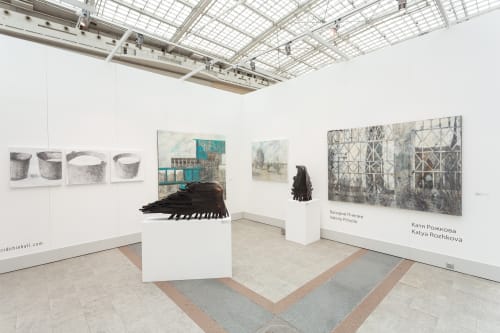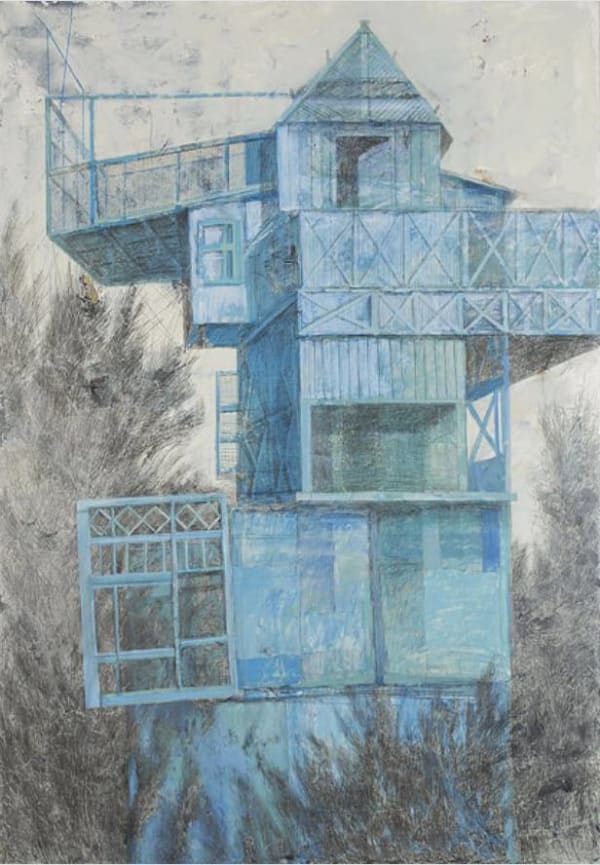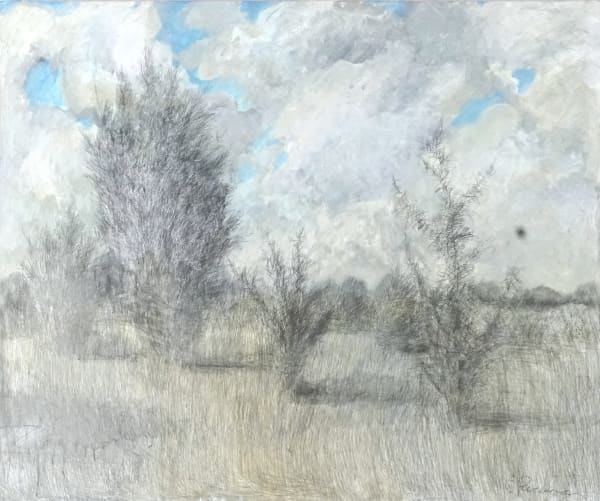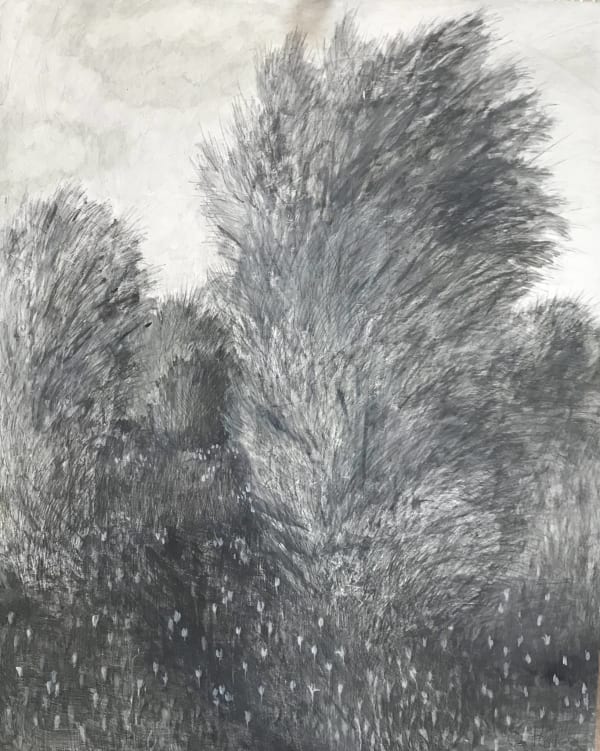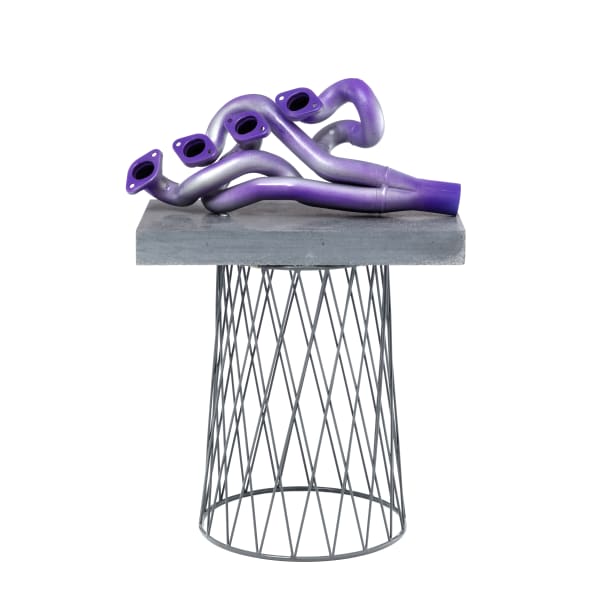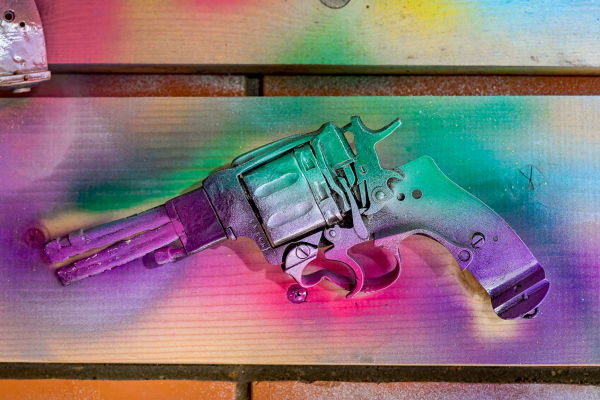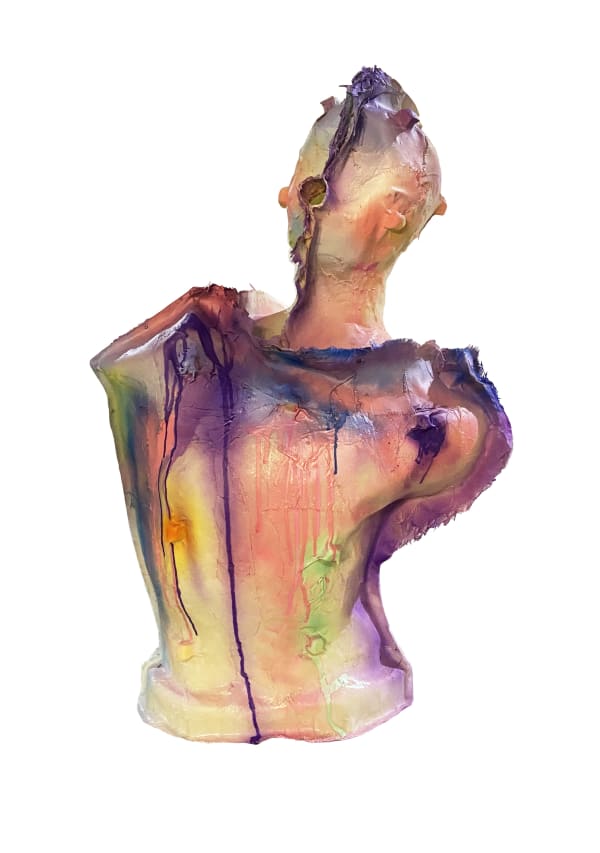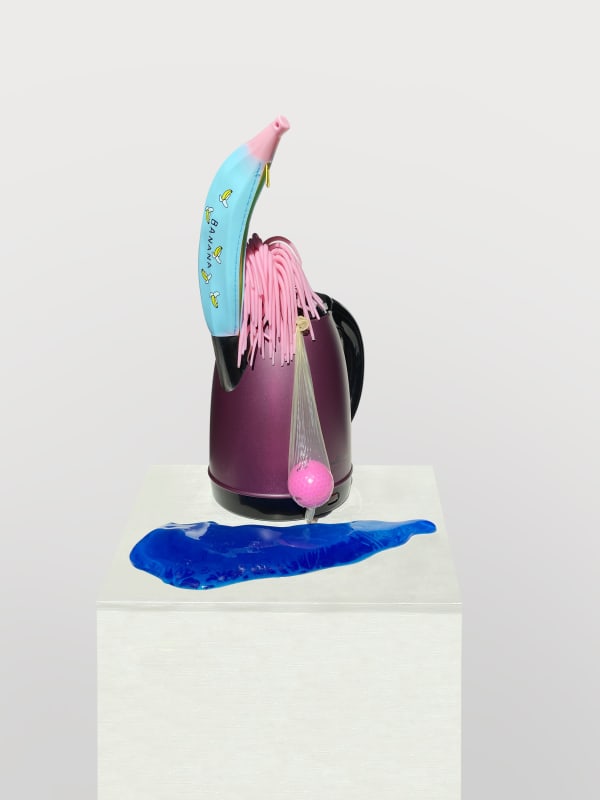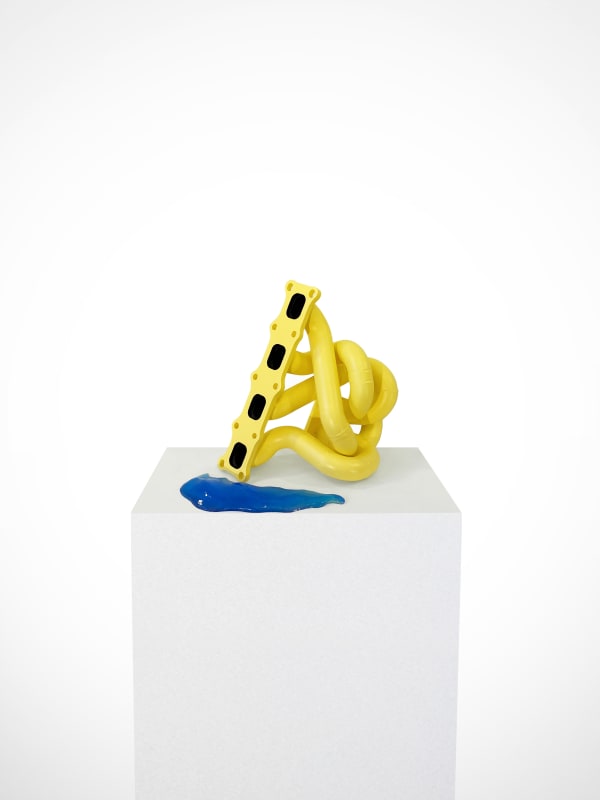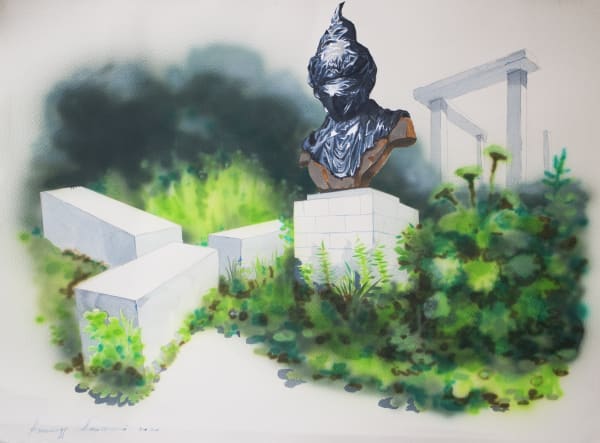COSMOSCOW 2020
Gridchinhall was represented at three stands. The main stand, C9, displayed paintings by Katya Rozhkova and sculptures by Valery Pchelin; stand A5 in the “Editions” section was completely dedicated to the sculptures of Valentin Korzhov; and 3 new graphic works by Aleksandr Dashevsky occupied part of the “Created in Moscow” section, curated by Aleksey Maslyayev and put together by the fair with help from the Moscow Government’s Department of Entrepreneurship. Three locations at the fair is a sound strategy: we can recommend visitors to one stand to stop by a second, and from there move on to the third. Gridchinhall becomes the dotted line visitors can follow during their travels through Cosmoscow.
The idea for the exhibition at the main stand, C9, began with contemplation of dotted lines. We thought that the graphic pencil lines in Rozhkova’s works would combine well with the bars of wood in Pchelin’s sculptures. That was our concept, in any case. We were only able to witness the incarnation of the idea after it was mounted. And if we are to go by reviews from visitors to the stand, we got it right.
The main stand was quite different from most of the galleries at the fair. Our colleagues were showing bright, colorful art, which is understandable, since it obviously attracts more attention. Our stand, however, was almost monochromatic, a place where visitors could rest their eyes. It turned out that the contrast worked in our favor. The more vibrant part of our gallery – Valentin Korzhov’s sculptures – were being shown at the GridchinLab stand, which was also quite animated.
Valery Pchelin manned the main stand, where he chatted with visitors and discussed his drifters. Having the artist himself at the stand is quite a bonus as well, as we can always fall back on “well, here’s the creator himself…” He can explain how each drifter is on the one hand disconnected, decaying, and chaotic, and on the other is complete, self-contained, and alive.
The semi-abstract objects demonstrate movement from fragmentation to wholeness, during which process resistance from the forces of nature – fire, wind, water – must be overcome. It is why the drifters are so dark, as if they had been scorched.
Pchelin makes them according to architectural principles, building them up layer by layer from the base. You can understand what direction a drifter is moving in by the position of its “feet”. A natural form can be perceived in the shape of each drifter. This might be, for instance, a tooth, a rhinoceros horn, or a bird’s wing.
-
 Katya RozhkovaWINDOW • ОКНО, 2015Canvas, acrylic, pencil
Katya RozhkovaWINDOW • ОКНО, 2015Canvas, acrylic, pencil
Холст, акрил, карандаш150 x 200 cm
59 1/8 x 78 3/4 in€ 14,000.00 -
 Katya RozhkovaDOVECOTE 2 • ГОЛУБЯТНЯ 2, 2010Canvas, pencil, acrylic
Katya RozhkovaDOVECOTE 2 • ГОЛУБЯТНЯ 2, 2010Canvas, pencil, acrylic
Холст, карандаш, акрил200 x 140 cm
78 3/4 x 55 1/8 in€ 16,000.00 -
 Katya RozhkovaENDLESS LANDSCAPE • БЕСКОНЕЧНЫЙ ПЕЙЗАЖ, 2019Canvas, mixed media
Katya RozhkovaENDLESS LANDSCAPE • БЕСКОНЕЧНЫЙ ПЕЙЗАЖ, 2019Canvas, mixed media
Холст, смешанная техника100 x 120 cm
39 3/8 x 47 1/4 inSold -
 Katya RozhkovaLANDSCAPE 1 • ПЕЙЗАЖ 1, 2019Canvas, acrylic, pencil
Katya RozhkovaLANDSCAPE 1 • ПЕЙЗАЖ 1, 2019Canvas, acrylic, pencil
Холст, акрил, карандаш
Private collection of Svetlana and Sergey Gridchin
Частная коллекция Светланы и Сергея Гридчиных150.2 x 120 cm
59 1/8 x 47 1/4 in -
 Valery PchelinDRIFTER 06 • ДРИФТЕР 06, 2018Oriental beech, black tinting, oil
Valery PchelinDRIFTER 06 • ДРИФТЕР 06, 2018Oriental beech, black tinting, oil
Кавказский бук, черная тонировка, масло, воск42 x 23 x 26 cm
16 1/2 x 9 1/8 x 10 1/4 in
Weight: 4,6 kg₽ 550,000.00 -
 Valery PchelinDRIFTER 09 • ДРИФТЕР 09, 2018Oriental beech, black tinting, oil, wax
Valery PchelinDRIFTER 09 • ДРИФТЕР 09, 2018Oriental beech, black tinting, oil, wax
Кавказский бук, черная тонировка, масло, воск79 x 43 x 25 cm
31 1/8 x 16 7/8 x 9 7/8 in
Weight: 5.1 kg₽ 550,000.00 -
 Valery PchelinDRIFTER 07 • ДРИФТЕР 07, 2018Caucasian beech, black tinted, oil, wax.
Valery PchelinDRIFTER 07 • ДРИФТЕР 07, 2018Caucasian beech, black tinted, oil, wax.
Кавказский бук, чёрная тонировка, масло, воск52 x 125 x 30 cm
20 1/2 x 49 1/4 x 11 3/4 inSold -
 Valery PchelinDRIFTER 03 • ДРИФТЕР 03, 2018Walnut, black tinting, oil, wax
Valery PchelinDRIFTER 03 • ДРИФТЕР 03, 2018Walnut, black tinting, oil, wax
Грецкий орех, черная тонировка, масло, воск45 x 35 x 18 cm
17 3/4 x 13 3/4 x 7 1/8 in
Weight: 7,6 kg₽ 380,000.00 -
 Valery PchelinDRIFTER 05 • ДРИФТЕР 05, 2018Caucasian beech, black tinted, oil, wax.
Valery PchelinDRIFTER 05 • ДРИФТЕР 05, 2018Caucasian beech, black tinted, oil, wax.
Кавказский бук, чёрная тонировка, масло, воск90 x 55 x 25 cm
35 3/8 x 21 5/8 x 9 7/8 in
Weight: 19,2 kg₽ 1,000,000.00 -
 Valentin KorzhovANIZOTROPIA #2 • АНИЗОТРОПИЯ #2, 2020Stainless steel, concrete
Valentin KorzhovANIZOTROPIA #2 • АНИЗОТРОПИЯ #2, 2020Stainless steel, concrete
Нержавеющая сталь, бетон70 x 35 x 35 cm
27 1/2 x 13 3/4 x 13 3/4 inEdition of 3Series: Анизотропия€ 4,000.00 -
 Valentin KorzhovBREAKFAST AT CRONUS #1 • ЗАВТРАК У КРОНОСА #1, 2020Steel gun
Valentin KorzhovBREAKFAST AT CRONUS #1 • ЗАВТРАК У КРОНОСА #1, 2020Steel gun
Стальной пистолет3 x 23 x 14 cm
1 1/8 x 9 1/8 x 5 1/2 inEdition of 5Series: Завтрак у Кроноса€ 1,250.00 -
 Valentin KorzhovBREAKFAST AT CRONUS #2 • ЗАВТРАК У КРОНОСА #2, 2020Steel gun
Valentin KorzhovBREAKFAST AT CRONUS #2 • ЗАВТРАК У КРОНОСА #2, 2020Steel gun
Стальной пистолет2 x 23 x 14 cm
3/4 x 9 1/8 x 5 1/2 inEdition of 5Series: Завтрак у Кроноса€ 1,250.00 -
 Valentin KorzhovBREAKFAST AT CRONUS #3 • ЗАВТРАК У КРОНОСА #3, 2020Steel gun
Valentin KorzhovBREAKFAST AT CRONUS #3 • ЗАВТРАК У КРОНОСА #3, 2020Steel gun
Стальной пистолет3 x 23 x 14 cm
1 1/8 x 9 1/8 x 5 1/2 inEdition of 5Series: Завтрак у Кроноса€ 1,250.00 -
 Valentin KorzhovBREAKFAST AT CRONUS #4 • ЗАВТРАК У КРОНОСА #4, 2020Steel gun
Valentin KorzhovBREAKFAST AT CRONUS #4 • ЗАВТРАК У КРОНОСА #4, 2020Steel gun
Стальной пистолет3 x 23 x 14 cm
1 1/8 x 9 1/8 x 5 1/2 inEdition of 5Series: Завтрак у Кроноса€ 1,250.00 -
 Valentin KorzhovBREAKFAST AT CRONUS #5 • ЗАВТРАК У КРОНОСА #5, 2020Steel gun
Valentin KorzhovBREAKFAST AT CRONUS #5 • ЗАВТРАК У КРОНОСА #5, 2020Steel gun
Стальной пистолет23 x 20 x 6 cm
9 1/8 x 7 7/8 x 2 3/8 inEdition of 5Series: Завтрак у Кроноса€ 2,000.00 -
 Valentin KorzhovBREAKFAST AT CRONUS #6 • ЗАВТРАК У КРОНОСА #6, 2020Mixed media
Valentin KorzhovBREAKFAST AT CRONUS #6 • ЗАВТРАК У КРОНОСА #6, 2020Mixed media
Смешанная техника38 x 25 x 12 cm
15 x 9 7/8 x 4 3/4 inEdition of 5Series: Завтрак у КроносаSold -
 Valentin KorzhovBREAKFAST AT CRONUS VII • ЗАВТРАК У КРОНОСА VII, 2020Fiberglass, mixed media
Valentin KorzhovBREAKFAST AT CRONUS VII • ЗАВТРАК У КРОНОСА VII, 2020Fiberglass, mixed media
Стекловолокно, смешанная техника120 x 100 x 50 cm
47 1/4 x 39 3/8 x 19 3/4 inSeries: Завтрак у Кроноса€ 20,000.00 -
 Valentin KorzhovBREAKFAST AT CRONUS III • ЗАВТРАК У КРОНОСА III, 2020Optic plastic, mixed media
Valentin KorzhovBREAKFAST AT CRONUS III • ЗАВТРАК У КРОНОСА III, 2020Optic plastic, mixed media
Стекловолокно, смешанная техника38 x 29 x 30 cm
15 x 11 3/8 x 11 3/4 inEdition of 5Series: Завтрак у Кроноса€ 2,950.00 -
 Valentin KorzhovANIZOTROPIA #11 • АНИЗОТРОПИЯ #11, 2020Stainless steel, concrete
Valentin KorzhovANIZOTROPIA #11 • АНИЗОТРОПИЯ #11, 2020Stainless steel, concrete
Нержавеющая сталь, бетон48 x 42 x 30 cm
18 7/8 x 16 1/2 x 11 3/4 inEdition of 3Series: Анизотропия€ 4,000.00 -
 Valentin KorzhovANIZOTROPYA III • АНИЗОТРОПИЯ III, 2019Fiberglass, supermarket trolley rolls, toy bricks
Valentin KorzhovANIZOTROPYA III • АНИЗОТРОПИЯ III, 2019Fiberglass, supermarket trolley rolls, toy bricks
Cтекловолокно, колёса тележки супермаркета, игрушечные кирпичи39 3/8 x 24 3/8 x 17 3/4 in
100 x 62 x 45 cm -
 Alexander DashevskiyMONUMENT TO A STRONG-WILLED MAN • ПАМЯТНИК ЦЕЛЬНОМУ ВОЛЕВОМУ МУЖЧИНЕ, 2020Paper, acrylic ink, airbrush, brush, pen
Alexander DashevskiyMONUMENT TO A STRONG-WILLED MAN • ПАМЯТНИК ЦЕЛЬНОМУ ВОЛЕВОМУ МУЖЧИНЕ, 2020Paper, acrylic ink, airbrush, brush, pen
Бумага, акриловая тушь, аэрограф, кисть, перо150 x 105 cm
59 1/8 x 41 3/8 inSold -
 Alexander DashevskiyMONUMENT TO THE ARTIST • ПАМЯТНИК ХУДОЖНИКУ, 2020Paper, acrylic ink
Alexander DashevskiyMONUMENT TO THE ARTIST • ПАМЯТНИК ХУДОЖНИКУ, 2020Paper, acrylic ink
Бумага, акриловая тушь56 x 75 cm
22 1/8 x 29 1/2 in€ 1,400.00 -
 Alexander DashevskiyREFLECTION • ОТРАЖЕНИЕ , 2020Paper, acrylic ink
Alexander DashevskiyREFLECTION • ОТРАЖЕНИЕ , 2020Paper, acrylic ink
Бумага, акриловая тушь113 x 100 cm
44 1/2 x 39 3/8 inSold
